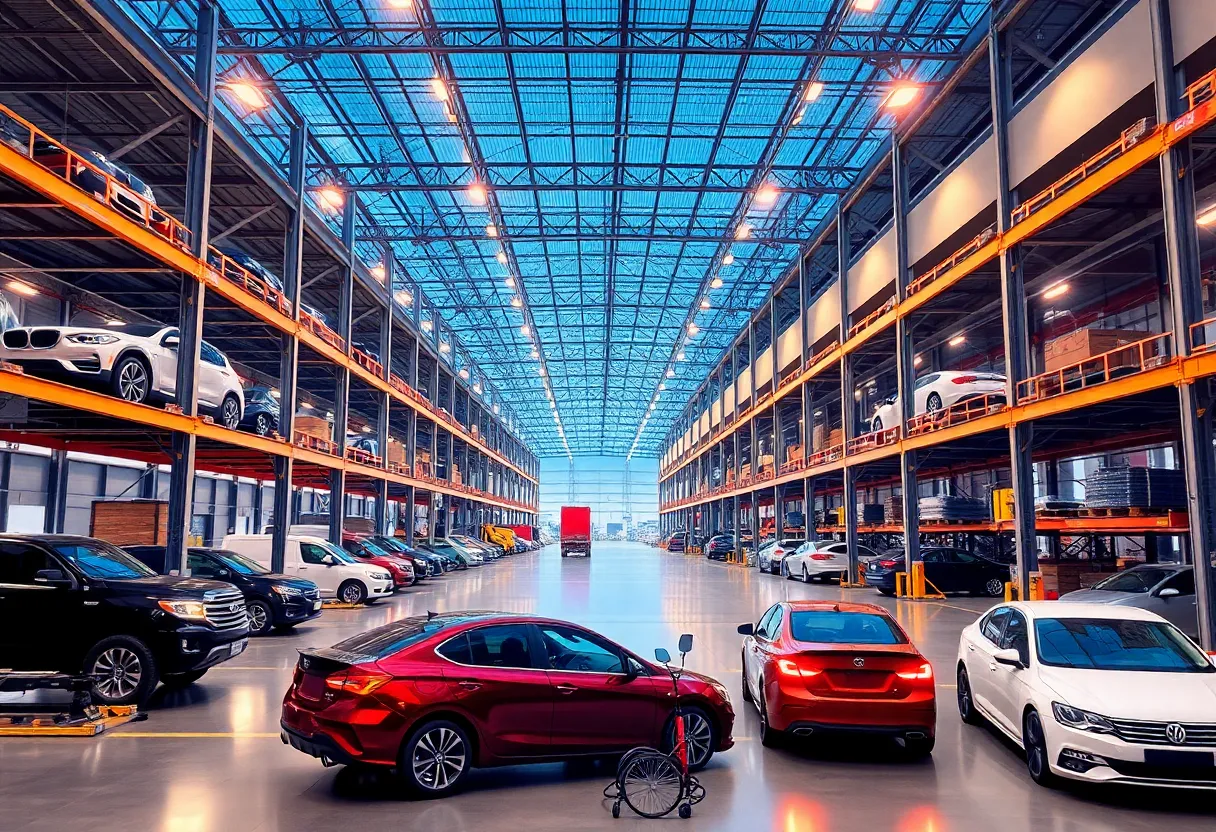Oklahoma City, October 19, 2025
Cox Automotive has launched a $60 million distribution hub in Oklahoma City’s Bricktown district. The 100,000-square-foot facility employs AI-driven inventory management, reduces lead times, and creates 250 jobs. The hub aims to benefit local auto businesses while supporting downtown revitalization through public art funding.
Oklahoma City Welcomes Major Automotive Distribution Hub
Cox Automotive Launches $60 Million Facility in Bricktown
Oklahoma City, OK – October 19, 2025: Cox Automotive has opened a 100,000-square-foot distribution hub in the city’s vibrant Bricktown district. This $60 million investment aims to streamline parts supply for dealerships throughout the South, marking a significant boost to the local economy and automotive sector.
The new facility employs AI-driven inventory management to reduce lead times by 40%, directly benefiting 200 local auto businesses. This efficiency is expected to accelerate vehicle repairs and sales, generating an estimated $120 million in added commerce. The hub creates 250 jobs, offering competitive wages and benefits that tap into the area’s unemployment pool, providing much-needed employment opportunities.
Strategic Location Enhances Logistics Efficiency
Oklahoma City’s central position makes it an ideal hub for logistics, enabling faster distribution across the region. The facility integrates with Cox Automotive’s digital platforms, introducing predictive maintenance through advanced data analytics—a first for the area. This technology allows dealerships to anticipate part needs, minimizing downtime and improving overall service delivery.
City officials view the project as a key driver for downtown revitalization. The company has committed to funding public art installations around the Bricktown area, enhancing the district’s cultural appeal while supporting community development. This move not only strengthens infrastructure but also positions Oklahoma City as a pivotal player in the $1 trillion U.S. automotive aftermarket.
Broader Economic Impact and Job Creation
The distribution center’s opening addresses longstanding challenges in parts supply chains, which have often delayed repairs and frustrated customers in the automotive industry. By cutting lead times significantly, the hub ensures that dealerships can maintain smoother operations, ultimately benefiting consumers with quicker access to services. Economic forecasters project that the ripple effects will extend beyond the immediate 250 jobs, stimulating growth in related sectors like transportation and retail.
The emphasis on competitive wages and comprehensive benefits is particularly noteworthy in a region working to reduce unemployment. These positions range from logistics specialists to data analysts, reflecting the hub’s reliance on both manual labor and cutting-edge technology. The integration of AI not only optimizes inventory but also sets a new standard for efficiency in Southern U.S. automotive logistics.
Context Within Oklahoma City’s Growing Business Landscape
Oklahoma City has been steadily building its reputation as a logistics powerhouse, thanks to its geographic advantages and ongoing infrastructure improvements. The Bricktown district, known for its entertainment and commercial vibrancy, now adds a high-tech automotive component to its portfolio. This development aligns with broader trends in the U.S. automotive aftermarket, where digital tools are transforming traditional supply chains.
While the aftermarket industry faces pressures from electric vehicle adoption and supply chain disruptions, initiatives like this hub demonstrate resilience and innovation. The facility’s focus on predictive analytics could serve as a model for other regions, helping to mitigate risks associated with global parts shortages. For local businesses, the benefits are immediate: faster access to components means higher throughput and potentially increased revenues.
In the larger picture, this expansion underscores Oklahoma City’s evolving role in national commerce. The $1 trillion automotive aftermarket relies heavily on efficient distribution, and this hub contributes by bridging gaps in the Southern market. Community enhancements, such as the public art funded by the project, further integrate the facility into the urban fabric, fostering a sense of shared progress.
The opening comes at a time when Oklahoma’s economy is diversifying beyond energy, with logistics emerging as a cornerstone. The 100,000-square-foot space is designed for scalability, allowing for future expansions as demand grows. Stakeholders anticipate that the $120 million in projected commerce will support tax revenues, funding further city improvements.
Implications for the Automotive Sector
For the 200 affected auto businesses, the reduced lead times translate to tangible gains in productivity. Dealerships can now stock parts more intelligently, avoiding overstocking or shortages that have plagued the industry. The AI systems in place provide real-time insights, enabling proactive decision-making that was previously unavailable at this scale in the region.
As Oklahoma City continues to attract investments, projects like this highlight the city’s preparedness for modern economic demands. The combination of job creation, technological advancement, and urban enhancement positions Bricktown as more than just a historic entertainment zone—it’s becoming a nexus for innovation in logistics and automotive services.
FAQ
What is the size and investment amount of the new distribution hub opened by Cox Automotive in Oklahoma City?
The distribution hub is 100,000-square-foot and involves a $60 million investment.
How does the facility benefit local auto businesses in Oklahoma City?
The facility employs AI-driven inventory management to cut lead times by 40%, benefiting 200 local auto businesses.
How many jobs does the hub create, and what are the employment benefits?
The hub creates 250 jobs, with competitive wages and benefits drawing from the unemployment pool.
What economic impact is forecasted from this project?
Economic forecasters estimate $120 million in added commerce from faster vehicle repairs and sales.
What technology does the hub integrate, and what is its significance?
Integration with Cox’s digital platforms enhances data analytics for predictive maintenance, a first in the region.
How does this project contribute to downtown revitalization?
City officials celebrate the project as a catalyst for downtown revitalization, including public art installations funded by the company.
What is the broader industry context for this development?
This expansion solidifies Oklahoma City’s role in the $1 trillion U.S. automotive aftermarket.
Key Features Chart
Below is a simple tabular chart outlining the key features of the Cox Automotive distribution hub in Oklahoma City.
| Feature | Details |
|---|---|
| Facility Size | 100,000-square-foot distribution hub in Bricktown district |
| Investment | $60 million |
| Technology | AI-driven inventory management reducing lead times by 40% |
| Job Creation | 250 jobs with competitive wages and benefits |
| Business Impact | Benefits 200 local auto businesses |
| Economic Projection | $120 million in added commerce |
| Integration | Data analytics for predictive maintenance, a regional first |
| Community Contribution | Public art installations for downtown revitalization |
| Industry Role | Strengthens position in $1 trillion U.S. automotive aftermarket |
Deeper Dive: News & Info About This Topic
HERE Resources
Love’s Travel Stops Expands with Major Acquisition





